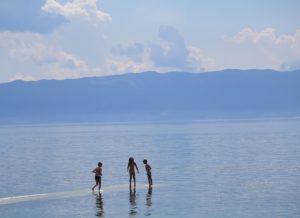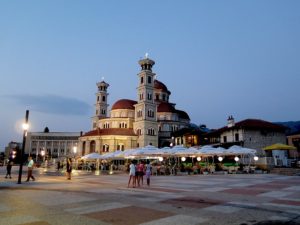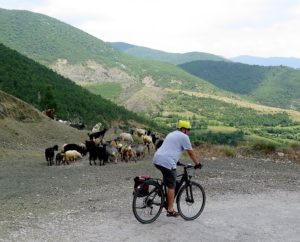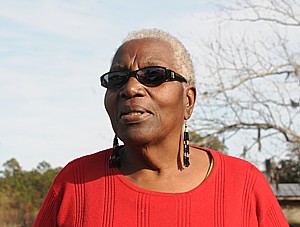
By Karen Rubin, Travel Features Syndicate, Goingplacesfarandnear.com
You wouldn’t necessarily come to Albania to see monuments and fabulous architecture, for museums that hold the treasures of civilization or the artifacts that trace your heritage (though one of the surprises are the important cultural and historic sites including a Greco-Roman city reclaimed from the forest overgrowth).
You wouldn’t necessarily come for fabulous beaches, though Albania possesses hundreds of miles of coastline along the Ionian and Adriatic Sea, and its own “Albanian Riviera” that reminds you of the French Riviera without the pretension.
You wouldn’t necessarily come for stunning and dramatic landscapes –though scenes abound of picturesque farmland that reminds you of Amish Country, dramatic mountains that reach into white clouds, sheer cliffs that drop to the sea, sunsets that take your breath away, villages carved into hillsides that look out to expansive galleys, giving a different hue to each of our days.

The scenery, the landscapes are strikingly beautiful to be sure – mountains that rise dramatically to white cumulus clouds, a coastline that follows the exquisitely aquamarine Ionian and Adriatic seas, valleys lush with immaculate farms with geometric patterns of color and texture. But most interesting of all are the contrasts without contradiction – farmers burnished by the sun to a leathery brown, working fields with hoes and spades or riding mule-drawn hay-carts up winding hillside roads while chatting on cell phones. In a country where a cinema or shopping mall or even retail stores are rarities, cell phones and cars (and car washes and petrol stations) are ubiquitous.
Certainly there are the beautiful landscapes, the picturesque countryside and stunning coastlines, ample historic and cultural attractions, and traditional tourist delights of beaches and sensational food.

But the best reason to come to Albania is for The Now, to see a young country shaking off a tortured past – “an unlucky history/country,” is the odd phrase our guide, Junid, uses.
Come to experience a place, a people and a culture that is shrouded in mystery after decades of being imprisoned behind an Iron Curtain, closed off to the world, under the thumb of a paranoid dictator, a place, a people and a culture that is either completely unknown or branded with misconceptions and false images.
To see that process unfolding is absolutely thrilling. Albania is not what it was 10 years ago, and is not what it will be in the next 10 years.
Surprises Abound
I was only in Albania a few minutes before I hear a story that proves foundational to my understanding: Albania, the only European country with a Muslim majority, was also the only European country to end World War II with more Jews than it had at the start of the war, because Albanians harbored Jews from the Nazis at great risk to their own lives and that of their children.
“Every one of the 200 Jews living in Albania before the war was hidden and taken care of by their mostly Muslim countrymen and countrywomen,” Jim Johnson, president of BikeTours.com who has designed this special “President’s Tour of Albania” that I am on, tells me, as we are taken from the airport to our hotel in the capital city of Tirana. “In fact, nearly 2,000 Jewish refugees fleeing Hitler were welcomed not as refugees but as guests and were ‘hidden in plain sight’ – made part of Albanian families and daily life. This endured even during the German occupation amid extreme threats by the Nazis.”
“The Jews were sheltered with their own children – which meant that if they were caught with Jews in their house, their own children would be killed,” our guide, Junid later relates when our group of five cyclists gathers for our first dinner together. “A lot stayed in the north – with Catholics. A lot went to Israel after the war. I’ve had groups where people went to back to the town where a family had sheltered their relatives.”
Why the Albanians would do this stems from an ancient code of honor, besa, that emphasizes “compassion and religious tolerance, that links personal honor to respect for and equality with others,” Junid explains. According to The Code, guests must be protected, even if it means losing one’s own life. “Talk to an Albanian today, and you’ll find they still consider their compassionate role during the Holocaust to be part of their national honor.”

That begins a series of wondrous surprises about a country that up until now has been largely completely unknown to Americans, who either have no impression or wrong impressions of Albania.
The first surprise is that Albania is a mere 75 minutes flight past Vienna in central Europe, where I switch planes from JFK. Geographically, Albania is part of the Balkans, bordered by Greece, Macedonia, Kosovo and Montenegro, and across the Adriatic Sea from Italy’s boot.
The second is discovering this country which for so long had been kept in isolation, shrouded in mystery. American travelers have come under the spell of Cuba and Myanmar – two other nations which have emerged from enforced isolation – but Albania deserves our attention to revel in how this young country is emerging.
The third surprise is that though Albania is majority Muslim (the only European country with a majority Muslim population), it is secular and tolerant of other prominent religions (Orthodox, Catholic), with a large strain of atheists stemming from when its Communist dictator, Envar Hoxha, (dictator from 1945-1985), banned religion altogether, burned down churches and mosques, murdered and imprisoned hundreds of clerics, and made Albania the first officially atheist country in the world. Even after the churches and mosques were reopened in the early 1990s, many remain atheists or keep their religion private. Indeed, I saw more women in headscarves in four days at the Democratic National Convention in Philadelphia, than in two weeks traveling through Albania.

The fourth surprise is that Albania (the correct name is Shqiperia, or more officially, Republika e Shqipërisë) is not an extension of Greece, Turkey or anywhere else. The Albanian language, Shqip, is Indo-European in origin and bears little resemblance to any other language today. And even though the alphabet is based on Latin (with a few additions), the sounds the letters make are very different, so you can’t pronounce, let alone read the signs. (See www.omniglot.com/writing/albanian.htm).
Each day, though, Junid, attempts to teach us an Albanian word. I wind up with “gezur” (which approximates to ”cheers” when you drink).
But with only 3.5 million Albanians left in the country after millions fled when the borders were finally opened with the fall of Communism and with the way Albania was divided up shortly after independence in 1912, there are more Albanian speakers outside the country than inside (90% of Montenegro, half of Macedonia’s Parliament and 5% of Greeks speak Albanian).
Albania uses its own currency, Lek (at this writing, 1 Albanian Lek equaled 0.0082 US Dollar, or less than one penny). The median income, I am told, is $5,000 a year. I found the value of items roughly 1/5 of the cost here – so a glass of wine (actually extremely good) in a restaurant was about $2; a mug of beer (also extremely good), about $1; admission to a historic site for foreigners about $5 (about $1.50 for Albanians). You could have an entire meal in a fine restaurant for less than $8. In other words, a pleasant surprise is how inexpensive it is to travel here.

Biking through the country, I am struck with how pleasant people are, how easy-going, how unstressed. We think of Albania being poor – its reputation is being the poorest country in Europe – but we have more severe and graver poverty in the US. You don’t see the extremes of rich and poor here. You don’t see squalor, hovels, hunger or homelessness (though we do encounter a few panhandlers in the popular tourist towns.)
In one of the most popular holiday cities, Saranda, when people come out at night (a custom in Albania), strolling the promenades along the Ionian Sea, it looks like Long Beach, Coney Island or Jones Beach – families, couples, gaggles of girls or boys. They stop at vendors selling popcorn, ice cream, toys, or sit in open-air restaurants and cafes. People are surprisingly scantily clad on the beaches and just strolling about – girls in tight, short revealing dresses, bare midriffs; couples showing affection, fellows wearing t-shirts that make statements of one sort or another; young people with tattoos. Most surprising to me is seeing fathers holding their infants and toddlers, and mothers who clearly have an equal status in their family, and how parents dote (even spoil) their kids.

I am struck by how relaxed people are. Perhaps this is because of the comparative stability and freedom – especially considering that the country underwent economic collapse and a civil war in the mid-1990s and is still considered one of the poorest, least developed in Europe. The situation seems stable even from 10 years ago, Junid confirms (I can relate to this, compared to the stress, hysteria and insecurity after the 2008 financial and housing collapse in the US, compared to the way people feel more secure in their homes and jobs now).
You don’t see ostentatious wealth or abject poverty. In some ways, Albania is described as a “subsistence economy” – people seem to have at least enough to get by, if not live comfortably. The Albanian people are polite, pleasant to one another (and to us), affectionate, fun-loving, like to laugh, seem easy-going, and dare I say, unstressed. It is as if a whole weight was removed when the oppression of Communism was lifted and people could be more free to show their emotions (I had experienced something similar when I first visited China in 1978, during the transition from the Gang of Four to the Four Modernizations, and then returned two years later to find the whole country transformed, as if a blizzard of fresh air had flowed through.)

Possibly the relative contentment I observe is related to the fact that there is very little consumerism – we see only one cinema (in Korca, considered the “Paris” of Albania, the most cosmopolitan city we experienced) and one place that could be construed as a “shopping mall” (also in Korca) – but what has become a ubiquitous item is cell phones. We see a man driving a donkey cart hauling hay talking on his cell phone; a woman in a field leaning against her hoe talking on her cell phone.
Also cars, petrol stations and car washes which crop up in the oddest places. During the Communism regime, no one was allowed to own a car (except for the Communist rulers who also availed themselves of magnificent waterfront villas). That leads to incongruous sights like a man riding a donkey passing a Kastrati gas station.
Cell phones, cars are the ubiquitous consumer items. And apart from restaurants, tavernas, cafes, beach holidays and bridal gowns, there seems to be little else. Simple pleasures prevail (though in Dhimare, we see jetskis, paragliding from the mountaintop, and Mercedes cars)

More surprises: how fantastic the food – literally fresh from farm or sea to table. With 300 miles of seacoast (the Adriatic and the Ionian Sea where we bike), we are treated to an abundance of fresh fish—sea bass, mussels, shrimp, squid freshly caught from the sea, farmed trout that finds its way to our plate minutes after being netted, and a fish that is uniquely found in Lake Ohrid. The abundant farms – which use organic practices – make farm-to-table meats—especially lamb and pork— as well as fruit and vegetables plentiful. Albanian cooking blends Mediterranean cuisine with Greek, Italian and Turkish influences; seasoning is mostly subtle – garlic and chili peppers – flavorful but not too spicy.
And water! Albania is rich in water which flows from the mountain tops – we fill our bottles from eternally flowing fountains. Some 70% of the country’s electricity is generated from hydroelectric power. Every structure uses solar panels to generate hot water.
Another surprise: while few older people speak English, most of the younger generation takes English in school, and seem very plugged into the rest of the world. And they seem to be very welcoming to Americans – indeed, they named a street in Tirana, the capital, for George W Bush after he became the first sitting American president to visit Albania, and only the day before we arrived in the country, a bust of Hillary Clinton was unveiled in Saranda. People are very welcoming to us, as well, when they learn we are Americans, and many Albanians have relatives in the US.
Everything about Albania is surprising. I knew nothing about this country before I arrived (as I expect is typical of most Americans) – I didn’t even know what city to fly into (Tirana, the capital, where almost 1 million of the 3.5 million Albanians live.)
Albania is so unexpected: how fun-loving and friendly people are, how immaculate the farms and how delicious the fresh produce (organic!) we eat at each meal, how picturesque the mountains (70% of the country), how the fresh water springs just flow, we just fill our water bottles from the rushing fountains; how lush the country is, how easy-going the people are, how scantily clad beachgoers are, how women wear tight, short, revealing dresses and men wear (sometimes) t-shirts with in-your-face slogans, and tattoos, how loving fathers are, how doting parents are of their children, how women seem to enjoy an equal relationship with their men. It is a majority-Muslim country that is secular, and tolerant; there are enormous Christian crosses dotting the countryside. How fascinating archeological sites like Butrint National Park, a UNESCO-protected city that extends back to Hellenic and Roman times (one of the most fascinating archeological sites I have ever experienced), and the UNESCO-protected Lake Ohrid area.
Other surprises we discover on our ride: Mother Teresa was Albanian (the international airport in Tirana is named for her), as was the scientist who found the drug that became Viagra (he was looking for a remedy for cardiovascular disease).

And the best way to engage, to discover Albania is by bike. Cars, buses would never come to these places – these back country roads, roads that have been bypassed by more recently constructed highways. They would go too fast to get any sense at all of moments that, on a bike, you can snatch up and savor, without the distorted unreality looking through glass windows. But from the perch of a bike saddle, you move at just the right pace, hear the sounds of cows mooing, the bleating of sheep; the bells attached to goats; have to sidestep goats or cows or donkeys walking on the road. You can smell the wild sage growing beside the road, and feel the moist coolness as you ride through the forest. We wave and say a cheery “hello” as we pass, and people wave back. You can stop – even chat- with a shepherd, or take the time to gaze and a scene and capture serendipity in a photo. Such was the experience of stopping to watch a funeral procession, a ritual of walking a goat around St. Naum monastery in advance of the annual feast day to honor the saint, kids frolicking on the Lake, a bride and groom posing for their wedding photos.
Each day is marked by very different landscapes, different tableaux – geographical and social – and distinctive experiences. You never know what you will see beyond the next turn in the road.
Here is another surprise: we are oddities as we ride through. Not because we are foreigners (it isn’t obvious that we are Americans), but because we are on bikes at all.
BikeTours,com
This was my third trip with BikeTours.com – which is not the bike tour operator but a broker that has assembled a catalog of local travel companies. They’ve done the search and checked out and selected top-notch companies to feature.
These are operators that supply the best bikes, itineraries, accommodations, meals, attractions at an excellent value (ie. about $150 a day, depending on choice of accommodations, and destination – or roughly half of what other tour operators charge).
BikeTours.com also provides superb pre-trip materials, coordinates the airport transfer, and if necessary, will steer you to a travel agent to book the air.
The self-guided Danube Bike Trail trip which I did with my two adult sons – charming bed and breakfast inn, accommodations, detailed directions, the guide spent 2 hours with us making sure the bikes fit and going over the route, suggesting places to visit.
The bike/boat trip through the Greek Isles was superb – great bikes fabulous guides, wonderful boat (wood hull, reminded me of a pirate ship), a fantastic itinerary.

This trip to Albania, a specially tailored “President’s Tour” (tacking on a couple of days kayaking in the Ionian Sea and a loop around Lake Ohrid into Macedonia) is a guided trip, and included three meals daily (so much food we had to tell our guide to order less); admissions to attractions, superb bikes (hydraulic brakes, suspension, 30-gears on the hybrids, or, in my case, e-bike that gave me super powers for climbing hills), supported with a van that followed behind us, and charming, comfortable accommodations (WiFi!) – like a guesthouse on a farm and a luxury boutique city hotel.
There are still some scheduled departures left this year for “Albania’s UNESCO Sites with Rivers, Valleys, and Gorges ,” 9 nights, Level 4, averaging 37 miles/day (950E or about $1050) (www.biketours.com/albania/albania-UNESCO-tour).
BikeTours.com 1-877-462-2423 or 423-756-8907, 1222 Tremont St., Suite 100, Chattanooga, TN 37405, biketours.com.
(More to come: Day by Day Biking in Albania)
____________________
© 2016 Travel Features Syndicate, a division of Workstyles, Inc. All rights reserved. Visit goingplacesfarandnear.com and travelwritersmagazine.com/TravelFeaturesSyndicate/. Blogging at goingplacesnearandfar.wordpress.com and moralcompasstravel.info. Send comments or questions to FamTravLtr@aol.com. Tweet @TravelFeatures. ‘Like’ us at facebook.com/NewsPhotoFeatures









